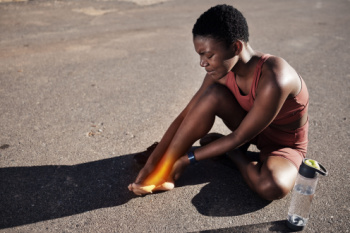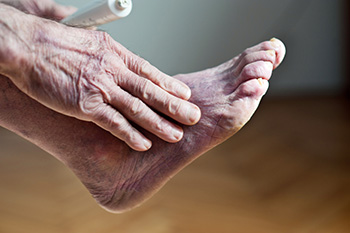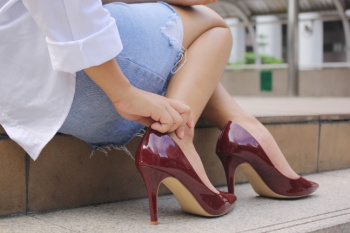
Cedarhurst (516) 374-3668
Franklin Square (516) 775-8440

Cedarhurst (516) 374-3668
Franklin Square (516) 775-8440

Dactylitis, commonly known as hand-foot syndrome, and associated with sickle cell disease, or SCD, manifests as painful swelling and inflammation in the fingers and toes, primarily affecting children. The condition arises from obstructed blood flow due to sickle-shaped red blood cells, which leads to tissue damage and discomfort. Treatment focuses on managing SCD symptoms, including pain relief and anti-inflammatory measures. Podiatrists, specializing in foot health, play a vital role in dactylitis management. They diagnose the condition, implement tailored treatment plans, and offer preventive care strategies. Podiatrists educate patients and families on foot hygiene and hydration, minimizing the risk of flare-ups. Regular monitoring by podiatrists ensures early intervention and prevents long-term complications, improving overall quality of life for individuals affected by dactylitis. If your child suffers from dactylitis, it is suggested that you schedule regular appointments with a podiatrist for care.
When dealing with systemic disease of the feet, it is extremely important to check the affected areas routinely so that any additional problems are caught quickly. If you have any concerns about your feet and ankles contact Robert Stein, DPM from South Shore Foot Care. Our doctor will assist you with all of your podiatric needs.
Systemic Diseases of the Feet
Systemic diseases affect the whole body, and symptoms usually are displayed in the feet. This condition can make a patient’s ability to walk unbearable. Systemic diseases include gout, diabetes mellitus, neurological disorders, and arthritis.
Gout – is caused by an excess of uric acid in the body. Common symptoms include pain, inflammation, and redness at the metatarsal/phalangeal joint of the base big toe. Gout can be treated by NSAIDs to relieve pain and inflammation, and other drugs that lower the acid levels in the body.
Diabetes mellitus – is an increase in the level of blood sugar that the body cannot counteract with its own insulin. Failure to produce enough insulin is a factor in Diabetes.
Diabetes of the Feet
Diabetic Neuropathy – may lead to damaged nerves and affect the feet through numbness and loss of sensation.
Peripheral Vascular Disease – can restrict the blood flow to the feet, and often times lead to amputation of the feet.
If you have any questions please feel free to contact our offices located in Cedarhurst and Franklin Square, NY . We offer the newest diagnostic and treatment technologies for all your foot and ankle needs.

Poor foot circulation, often linked with conditions like peripheral artery disease or diabetes, presents diverse symptoms such as numbness, tingling, weakness, coldness, or cramping in the feet and legs. This condition is more common as one ages. Restricted blood flow deprives tissues of oxygen and nutrients, causing discomfort and potentially severe issues like non-healing wounds or ulcers. The causes typically involve arterial narrowing or blockage due to factors such as smoking, high blood pressure, cholesterol, or diabetes. Lifestyle changes like quitting smoking, managing health conditions, staying active, and a healthy diet can aid in circulation improvement. If you have poor foot circulation and it is persistent or worsening, it is suggested that you seek prompt evaluation by a podiatrist. This type of doctor employs various diagnostic tests to assess circulation and devises personalized treatment strategies that can address underlying conditions and relieve symptoms.
While poor circulation itself isn’t a condition; it is a symptom of another underlying health condition you may have. If you have any concerns with poor circulation in your feet contact Robert Stein, DPM of South Shore Foot Care. Our doctor will treat your foot and ankle needs.
Poor Circulation in the Feet
Peripheral artery disease (PAD) can potentially lead to poor circulation in the lower extremities. PAD is a condition that causes the blood vessels and arteries to narrow. In a linked condition called atherosclerosis, the arteries stiffen up due to a buildup of plaque in the arteries and blood vessels. These two conditions can cause a decrease in the amount of blood that flows to your extremities, therefore resulting in pain.
Symptoms
Some of the most common symptoms of poor circulation are:
Treatment for poor circulation often depends on the underlying condition that causes it. Methods for treatment may include insulin for diabetes, special exercise programs, surgery for varicose veins, or compression socks for swollen legs.
As always, see a podiatrist as he or she will assist in finding a regimen that suits you. A podiatrist can also prescribe you any needed medication.
If you have any questions, please feel free to contact our offices located in Cedarhurst and Franklin Square, NY . We offer the newest diagnostic and treatment technologies for all your foot care needs.

High heels can have a detrimental effect on your feet, extending beyond mere discomfort. The forward weight shift caused by any heel height can lead to various issues, including hip, back, and knee pain. The pressure exerted on the toes can result in conditions such as bunions and ingrown toenails, while tendinitis may develop over time, especially as one ages. Switching to flats as one ages may not offer relief either. This shift can cause its own set of problems since tendons tighten from high heel wear. Additionally, one can suffer from Morton’s neuroma, and the fat pad beneath the feet tends to thin out with age, leading to metatarsalgia. Moreover, the unstable nature of high heels increases the risk of twisting an ankle. If you wear high heels and either want to continue to do so, or you have sustained foot problems as a result of wearing them, it is suggested that you schedule an appointment with a podiatrist. This type of doctor can offer you treatment options and guide you in choosing alternative shoes that can improve foot health.
High heels have a history of causing foot and ankle problems. If you have any concerns about your feet or ankles, contact Robert Stein, DPM from South Shore Foot Care. Our doctor can provide the care you need to keep you pain-free and on your feet.
Effects of High Heels on the Feet
High heels are popular shoes among women because of their many styles and societal appeal. Despite this, high heels can still cause many health problems if worn too frequently.
Which Parts of My Body Will Be Affected by High Heels?
What Kinds of Foot Problems Can Develop from Wearing High Heels?
How Can I Still Wear High Heels and Maintain Foot Health?
If you want to wear high heeled shoes, make sure that you are not wearing them every day, as this will help prevent long term physical problems. Try wearing thicker heels as opposed to stilettos to distribute weight more evenly across the feet. Always make sure you are wearing the proper shoes for the right occasion, such as sneakers for exercising. If you walk to work, try carrying your heels with you and changing into them once you arrive at work. Adding inserts to your heels can help cushion your feet and absorb shock. Full foot inserts or metatarsal pads are available.
If you have any questions please feel free to contact our offices located in Cedarhurst and Franklin Square, NY . We offer the newest diagnostic and treatment technologies for all your foot and ankle needs.

Running is a fantastic way to stay fit, but it comes with risks, particularly for the feet and ankles. With a complex network of bones and joints, these areas are prone to injury. One common ailment is plantar fasciitis, characterized by sharp pain in the heel or arch. Ankle sprains, caused by twisting or rolling the ankle, are also prevalent among runners, leading to swelling and instability. Morton's neuroma, a nerve condition, manifests as a sharp, burning pain in the ball of the foot. Given the intricacies involved, if you run for fun or sport, and you have sustained a foot or ankle injury or desire guidance, it is suggested that you schedule an appointment with a podiatrist who can provide valuable insights into footwear selection, running techniques, and personalized treatment plans for injuries.
Ankle and foot injuries are common among athletes and in many sports. They can be caused by several problems and may be potentially serious. If you are feeling pain or think you were injured in a sporting event or when exercising, consult with Robert Stein, DPM from South Shore Foot Care. Our doctor will assess your condition and provide you with quality foot and ankle treatment.
Common Injuries
The most common injuries that occur in sporting activities include:
Symptoms
Symptoms vary depending upon the injury and in some cases, there may be no symptoms at all. However, in most cases, some form of symptom is experienced. Pain, aching, burning, bruising, tenderness, tightness or stiffness, sensation loss, difficulty moving, and swelling are the most common symptoms.
Treatment
Just as symptoms vary depending upon the injury, so do treatment options. A common treatment method is known as the RICE method. This method involves rest, applying ice, compression and elevating the afflicted foot or ankle. If the injury appears to be more serious, surgery might be required, such as arthroscopic or reconstructive surgery. Lastly, rehabilitation or therapy might be needed to gain full functionality in the afflicted area. Any discomfort experienced by an athlete must be evaluated by a licensed, reputable medical professional.
If you have any questions, please feel free to contact our offices located in Cedarhurst and Franklin Square, NY . We offer the newest diagnostic and treatment technologies for all your foot care needs.

Stretching the feet regularly can play a significant role in preventing foot and ankle problems and maintaining overall foot health. Targeted stretches such as toe splays, Achilles stretches, and big toe stretches help improve flexibility, strengthen muscles, and reduce tension in the feet and ankles. Toe splays involve spreading the toes apart to alleviate tightness and improve mobility. Achilles stretches target the calf muscles and Achilles tendon, enhancing the range of motion and reducing strain on the heel. Big toe stretches help maintain flexibility in the joint, promoting proper gait mechanics and preventing conditions like bunions and plantar fasciitis. A podiatrist can offer valuable guidance on appropriate stretching techniques and recommend a personalized stretching routine based on individual needs and existing foot issues. Additionally, podiatrists can assess biomechanical imbalances and provide custom orthotics or other interventions to complement stretching exercises and optimize foot health. If you would like to learn more about maintaining good foot and ankle health, including stretching, it is suggested that you schedule an appointment with a podiatrist to discuss this further.
Stretching the feet is a great way to prevent injuries. If you have any concerns with your feet consult with Robert Stein, DPM from South Shore Foot Care. Our doctor will assess your condition and provide you with quality foot and ankle treatment.
Stretching the Feet
Stretching the muscles in the foot is an important part in any physical activity. Feet that are tight can lead to less flexibility and make you more prone to injury. One of the most common forms of foot pain, plantar fasciitis, can be stretched out to help ease the pain. Stretching can not only ease pain from plantar fasciitis but also prevent it as well. However, it is important to see a podiatrist first if stretching is right for you. Podiatrists can also recommend other ways to stretch your feet. Once you know whether stretching is right for you, here are some excellent stretches you can do.
It is best to go easy when first stretching your foot and work your way up. If your foot starts hurting, stop exercising and ice and rest the foot. It is advised to then see a podiatrist for help.
If you have any questions, please feel free to contact our offices located in Cedarhurst and Franklin Square, NY . We offer the newest diagnostic and treatment technologies for all your foot care needs.
Every patient is unique and so are treatments. The information on this website is for educational purposes and each individual
patient care model may differ.